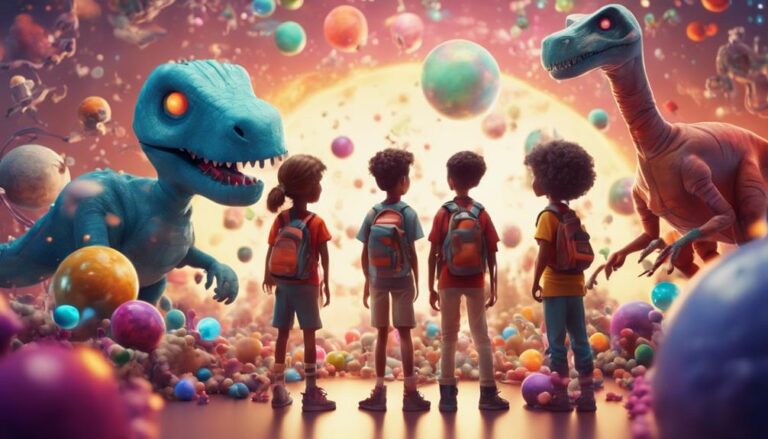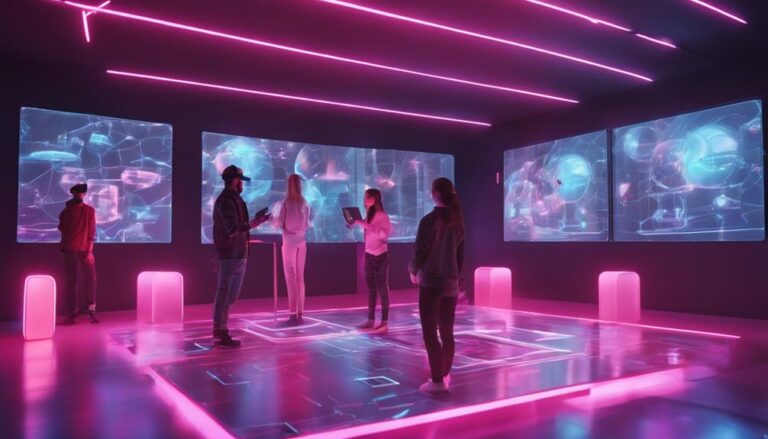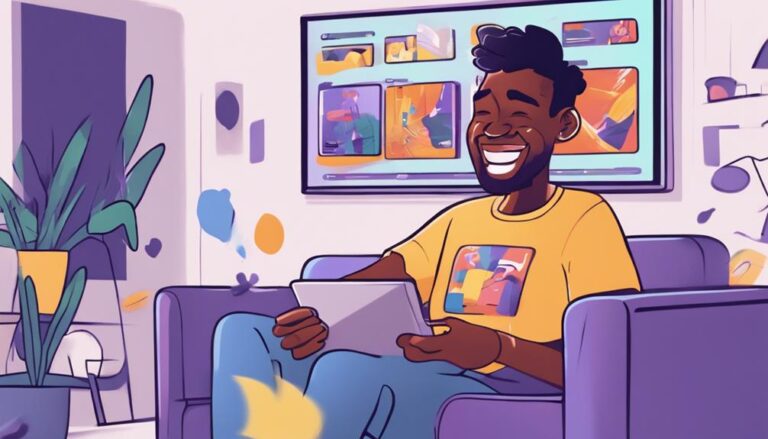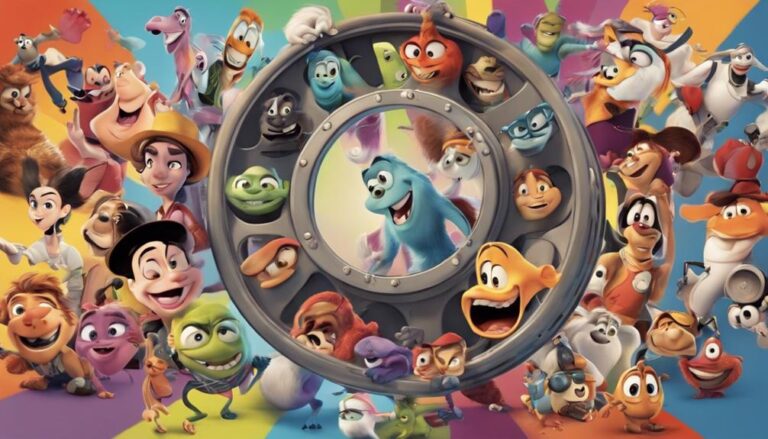10 Essential Storyboarding Tips for Animation Success
You start building the foundation of a compelling animated film or series by developing a strong storyboard, which is crucial for a project's success. Begin with a clear script, breaking it down into individual shots and scenes, and make necessary changes for clarity and consistency. Keep your storyboard simple and clean, focusing on essential story elements. Use storyboarding software to create and refine boards efficiently. Don't forget to plan camera angles carefully and create a visual flow that draws the audience in. As you revise and refine your storyboard, you'll uncover more essential tips to elevate your animation to the next level.
Key Takeaways
- Break down the script into individual shots and scenes to visualize pacing and flow in your animation.
- Use simple drawings and a consistent visual style in your storyboard to focus on essential story elements.
- Vary shot lengths and types to add visual interest and control the tempo of your animation.
- Establish a clear visual flow that guides the viewer's eye through the sequence of shots and key story beats.
- Use storyboarding software to create, refine, and compare boards quickly and efficiently.
Start With a Clear Script
One crucial step in creating an effective animation storyboard is to start with a clear script.
You've likely spent a lot of time developing your script, so now it's time to visualize it. As you start storyboarding, you'll begin to see your script come to life, and any issues with pacing or plot holes will become apparent.
To ensure your script is ready for storyboarding, review it carefully and make any necessary changes.
Check for clarity and consistency in your characters' dialogue and actions. Consider your target audience and the overall tone you want to convey. A well-written script will guide your storyboarding process and help you stay focused on the story you want to tell.
When you're happy with your script, break it down into individual shots and scenes.
This will help you visualize the pacing and flow of your animation. Use this breakdown to identify any areas where your script may need further refinement.
Keep It Simple and Clean
While developing your animation storyboard, it's essential that you don't get too caught up in the details – your primary goal should be to effectively convey the sequence of events and overall flow of your animation.
Keep your drawings simple and clean, avoiding clutter and excessive details. This will help you focus on the essential elements of your story and ensure that your message is clearly communicated.
You should also use a consistent visual style throughout your storyboard, using simple shapes and lines to represent characters, objects, and environments.
Avoid shading or coloring, as these can be distracting and make your storyboard harder to read. Keep your panels clean and uncluttered, with clear labels and captions to help explain the action.
Use Storyboard Software
A digital canvas can be a game-changer for animators, especially when it comes to storyboarding.
You can use storyboarding software to create and refine your boards quickly and efficiently. There are many software options available, including TVPaint Animation, Adobe Animate, and Toon Boom Harmony. Each of these programs has its own unique features, so it's essential to experiment and find the one that works best for you.
Using storyboarding software allows you to easily make changes to your boards without having to redraw entire scenes.
You can also create multiple versions of a board and compare them side by side. This feature is especially useful when you're trying to decide on the best pacing for a scene.
Additionally, many storyboarding software programs allow you to add notes and audio to your boards, making it easier to communicate with your team and clients.
Plan Camera Angles Carefully
When planning camera angles, you'll want to consider how they'll impact the overall composition of each frame.
You're not just deciding where to place the camera, but also how to guide the viewer's eye and create a sense of emotion or tension.
Frame Composition Matters
Your frame composition is crucial in animation storyboarding. It can make or break the mood, pacing, and overall feel of your animation.
When you're planning your camera angles, don't forget to think about what's in the frame and how it's arranged. Consider the rule of thirds, where you place important elements along lines that divide the frame into thirds. This creates balance and visual interest.
As you compose your frames, think about the negative space, too.
Don't overcrowd the frame with too many elements. Leave some space to create a sense of breathing room and to draw the viewer's eye to the important parts.
Also, consider the placement of your characters and objects. Where are they in relation to each other? How are they interacting with the environment?
These are all important considerations that will help you create a cohesive and engaging visual narrative.
Choose the Right Shot
Planning camera angles carefully is vital to bringing your animation to life, as it helps to create the desired mood and convey the intended message.
When choosing the right shot, you're not only deciding what to show, but also how to show it. This is where your creativity and vision come into play.
You've got to think about the type of shot that'll best capture the action, emotion, or drama of a scene.
Here are some key considerations:
- *Establishing shot*: Use a wide-angle shot to set the scene and establish the location.
- *Medium shot*: Capture your character from the waist up to convey their emotions and reactions.
- *Close-up shot*: Zoom in on your character's face to emphasize their feelings and create a sense of intimacy.
- *Over-the-shoulder shot*: Use this shot to show conversations between characters and create a sense of depth.
Create a Visual Flow
A well-crafted storyboard is all about creating a visual flow that draws the audience in.
You want to guide the viewer's eye through the sequence of shots, creating a cohesive narrative that's easy to follow. To achieve this, consider the pacing of your shots. Varying the length and type of shots can add visual interest and control the tempo of your animation.
Pay attention to the placement of characters and objects within each shot.
Balance the composition to create a clear focal point, leading the viewer's eye to the most important element. Use visual connections between shots to create a sense of continuity. This can be achieved by matching action, using similar framing, or incorporating visual motifs.
As you create your visual flow, think about the emotional tone you want to convey.
Use lighting, color, and composition to set the mood and atmosphere. By carefully crafting your visual flow, you can engage your audience and draw them into the world of your animation. A well-designed visual flow is essential for creating an immersive and engaging story.
Focus on Key Story Beats
The animation's key story beats are the moments that drive the narrative forward, revealing character, advancing the plot, or setting the tone.
When you're creating your storyboard, it's essential to focus on these key beats, as they're the backbone of your story. By emphasizing these moments, you'll keep your audience engaged and invested in the story.
To identify the key story beats in your animation, consider the following:
- What're the most critical plot points that move the story forward?
- What character revelations are crucial to the narrative?
- What tone or atmosphere do you want to establish in specific scenes?
- What're the most intense or dramatic moments in the story?
Add Emotional Depth Quickly
To add emotional depth to your animation quickly, focus on establishing an emotional connection with your audience through your characters' experiences.
You'll want to consider the essential elements that make your characters relatable and believable, such as their quirks, strengths, and weaknesses.
Establish Emotional Connection
Establishing an emotional connection with your audience is crucial in animation, as it not only captures their attention but also drives the story forward.
You want your viewers to invest in your characters and story, and a strong emotional connection is key to achieving this. To establish this connection, you need to create a sense of empathy and understanding between your audience and characters.
- Use character expressions and body language to convey emotions, making your characters more relatable and authentic.
- Show your characters' vulnerabilities and weaknesses to create a sense of empathy and connection with your audience.
- Use music and sound effects to enhance emotional moments and create a more immersive experience.
- Keep your emotional moments concise and impactful, avoiding overly dramatic or clichéd scenes that can detract from the story.
Character Development Essentials
Your character's emotional depth is the backbone of a compelling story, as it humanizes them and makes their journey more relatable.
You can add emotional depth quickly by considering their emotional vulnerabilities and strengths. What're they afraid of, and what makes them feel safe? How do they react to stress, and what calms them down?
These details will help you create a well-rounded character that audiences can empathize with.
When developing your character, think about their body language, facial expressions, and tone of voice.
How do these nonverbal cues convey their emotions and personality? Consider their relationships with other characters, too.
How do they interact with friends, family, and enemies? These interactions can reveal a lot about their emotional depth and create opportunities for character growth.
Motivation and Backstory
As you flesh out your character's emotional landscape, considering their motivation and backstory can add emotional depth quickly.
By understanding what drives your character and the events that shaped them, you'll be able to create more authentic interactions and meaningful connections with your audience.
To effectively tap into your character's motivation and backstory, keep the following points in mind:
- *Define the character's core desire*: What do they want to achieve or gain? What's driving their actions and decisions?
- *Identify past experiences that shape their perspective*: What events have led them to their current state? How do these experiences influence their motivations?
- *Explore their emotional vulnerabilities*: What're their deepest fears and insecurities? How do these vulnerabilities impact their interactions with others?
- *Keep it concise and relevant*: Avoid overloading your character with too much backstory. Focus on the details that are essential to their emotional journey and the story's progression.
Revise and Refine Often
A successful storyboard doesn't just happen overnight – it's the result of a process that involves multiple revisions.
You'll need to be open to making changes and refining your work to ensure it's the best it can be.
As you review your storyboard, look for areas where pacing, timing, or character development can be improved.
You might need to rework entire scenes or make subtle tweaks to individual shots.
When revising your storyboard, ask yourself questions like: Are the character's actions consistent with their personality?
Is the pacing well-balanced between action and quiet moments?
Are there any plot holes or inconsistencies?
Be honest with yourself, and don't be afraid to make significant changes if needed.
Refine your storyboard by paying attention to details such as character placement, camera angles, and transitions between scenes.
By revising and refining your work, you'll create a stronger, more engaging storyboard that will help bring your animation to life.
Regular revisions will help you stay on track and ensure your final product meets your vision.
Practice and Experiment Regularly
To get the most out of your practice, try the following:
- *Use reference images* to help you draw more accurately and realistically.
- *Create storyboards for different genres* to challenge yourself and broaden your skills.
- *Experiment with different shot types* to add variety to your boards.
- *Draw from life* to improve your observation and drawing skills.
Collaborate With the Team
When you collaborate with your team on a storyboard, it's essential that you assign clear roles to avoid confusion and overlapping work.
By doing so, you'll ensure that each team member knows their responsibilities and can work efficiently.
Establishing open communication channels will also help you share your vision, receive feedback, and make necessary adjustments throughout the process.
Assign Clear Roles
- Assign a storyboard artist to create the initial boards and revisions based on your feedback.
- Designate a director or creative lead to guide the overall vision and provide feedback on the boards.
- Appoint a producer or project manager to oversee the project's progress, budget, and timeline.
- Identify a visual development artist to create concept art and reference images that inform the storyboard.
Open Communication Channels
Effective collaboration begins with establishing open channels of communication among your team members, who'll be working together to bring your story to life. This means you'll need to set up regular meetings and encourage everyone to share their thoughts, ideas, and concerns.
| Communication Methods | Benefits |
|---|---|
| Team Meetings | Encourage collaboration and discussion among team members. |
| Project Management Tools | Help you stay organized and ensure everyone's on the same page. |
| Instant Messaging Apps | Allow team members to quickly and easily ask questions or share updates. |
When it comes to collaboration, it's essential to create an environment where everyone feels comfortable sharing their ideas. This means being open to feedback and criticism, and being willing to make changes when necessary. By keeping the lines of communication open, you'll be able to catch any potential issues early on and make adjustments before they become major problems. This will help you create a cohesive and polished animation that you can be proud of.
Frequently Asked Questions
Can I Storyboard Without Drawing Skills?
You can create a storyboard without drawing skills. Focus on visualizing the sequence of events, and use simple stick figures or rough sketches to convey your ideas – it's about the story, not the art.
How Long Does Storyboarding Typically Take?
You're probably wondering how long storyboarding typically takes. It really depends on the project's complexity, but you can expect to spend anywhere from a few days to several weeks perfecting your boards.
Can I Storyboard Using Just Thumbnails?
You can definitely storyboard using just thumbnails. This technique helps you quickly visualize the overall pacing and shot sequence, making it ideal for initial planning or sharing ideas with your team or collaborators.
Is It Necessary to Include Every Detail?
You don't need to include every detail in your storyboards. Focus on key actions, camera angles, and pacing to convey the overall scene. You can leave minor details for later in the animation process.
Can Storyboards Be Used for Live-Action Films?
You can use storyboards for live-action films, helping you visualize scenes and shots before filming. It saves time and resources by identifying potential issues, allowing you to make necessary changes and adjustments beforehand.
Conclusion
You've mastered the essentials of storyboarding for animation success. By following these tips, you'll be well on your way to creating compelling, engaging stories that captivate your audience. Remember to stay flexible and open to feedback, and don't be afraid to try new things. With practice and dedication, you'll develop a keen eye for storytelling and a skillset that will serve you well in the world of animation. Your next project is waiting – get storyboarding.






